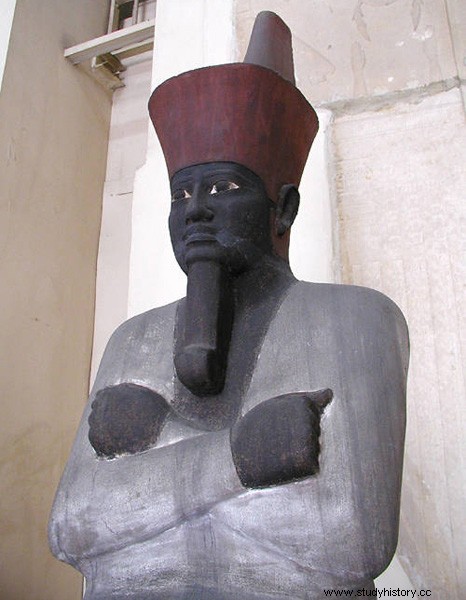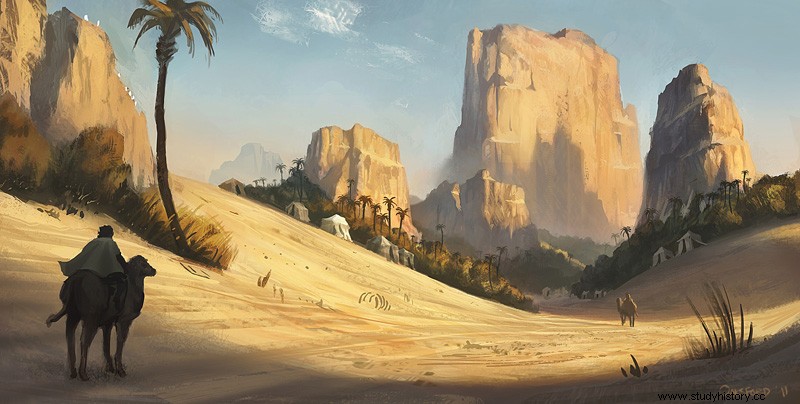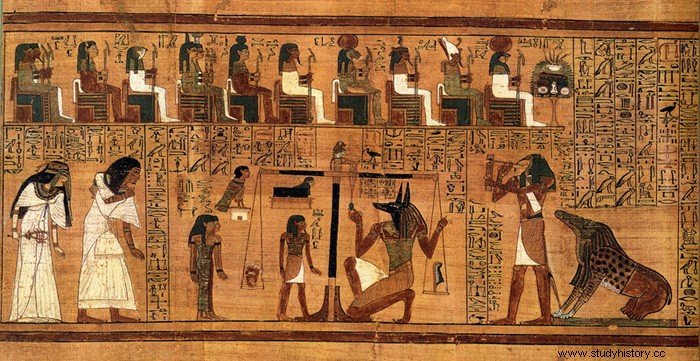XI AND XII DYNASTIES:
The Middle Kingdom marks a bright new period in the history of Ancient Egypt .

AROUND 2060 B.C. AD
Triumph of Mentuhotep I:
Mentuhotep I extends his power over Lower Egypt and unite the country again. He waged war in the neighboring countries, in the northeast against the people who came from Asia , in the northwest against the Libyans , to the south against the Nubians. He won victory after victory and restored the country's prosperity and stability. He reigns over Thebes which becomes the capital of the kingdom and raises the god Amon to the rank of the great Egyptian gods. Amun will be associated with rê (sun god of the city of Heliopolis), and will become Amun-rê during the New Kingdom. Mentuhotep I builds new temples, sanctuaries, etc., and restores the monarchy . He surrounded himself with an efficient administration of scribes and officials while the people resumed work.
CIRCA 1991 B.C. AD
Reign of Amenemhat I:
On the death of Mentuhotep III, his vizier Amenemhat (name which means “Amon is at the head”) seizes power and, supported by the powerful nomarchs, is crowned pharaoh . He transfers the capital to Licht (also called Fayoum oasis).
Agricultural and mining is abundant and military power is stabilized:

The pharaohs of the XIIth dynasty extend their domination over Nubia , a region rich in quarries and gold mines. They also exploit the mines of Sinai and the eastern desert, and strengthen their influence in Syria-Palestine. They built a powerful fortification in the east of the delta, called the "Prince's Walls", in order to protect the country from foreign invaders. Thanks to these enormous brick castles, 5 to 6 meters high, the soldiers watch the borders already well protected by the aridity of the desert.
The satire of trades:
To instruct Sesostris I, Amenemhat I had the scribe Khéty write a manual called “Teaching of Amenmhat “. Inspired by the writing of this book, Khéty decided to write another manual describing the harsh life of Egyptian craftsmen. He wishes, through these writings, to encourage his son to choose the profession of scribe . The book describes the other professions in an apocalyptic way and testifies to the contempt that the literate have for the illiterate peasants. It also reflects the importance of the scribe in Egyptian social life.
Extract:“I saw a blacksmith at work at the mouth of his oven; his fingers are like crocodile skin and he smells worse than fish eggs. The barber shaves until the evening limits, he places himself in his sector and goes from street to street, looking for someone to shave. The potter, his clothes are stiff with earth, his belt in tatters, the air that enters his nostrils is hot, because it comes out of the fire. The cobbler is going very badly for him too, he has to beg forever, he feels good as someone who lives among corpses would feel good, what he can get his teeth into is leather. The washerman washes on the shore and he is close to the crocodiles.”

Sesostis III stabilizes royal and political power:
He totally reorganizes the administration of his kingdom to limit the power of the unique vizier . He shares the responsibilities and creates 3 ministries:One for the north, one for the south and one for the “head of the south” (i.e. Nubia ). Each ministry has a rapporteur , a second rapporteur and a advice who decides and transmits orders to officers who, in turn, order the scribes . This mode of operation is a novelty which makes the nobility lose its influence and favors the middle classes. These become more numerous and less dangerous for the royal power.
Artistic revival:
Population growth sparked a period of economic and cultural renaissance called “classical age”. An intellectual and brilliant life reappears at court and in the aristocracy. The art becomes very refined in architecture, statuary or goldsmithing and artists reach a rare degree of perfection with instruments of great simplicity. Literature produces masterpieces, tales and novels flourish. The language of this period is a model of purity, admired until Roman times. Monumental construction projects are implemented and the pharaohs are still buried under pyramids . Funerary and magical rituals are popularized and every man can now be welcomed by the gods after his death.
Weighing the heart:
Egyptians believe in judgment after death. After a long evolution, the books of the dead mention from the Middle Kingdom, a tribunal during which the heart of the deceased is measured. The deceased is accompanied in this ordeal by the god-jackal Anubis . Osiris , the ruler of the kingdom of the dead, presides over the session, surrounded by 42 other deities. In front of him is a scale watched over by the god Thoth , patron saint of scribes . The heart of the deceased is placed on one of the scales and must not weigh more than the feather of Maât , goddess of truth and justice, resting on the other. The dead person trembles because his heart is the witness of his conduct on earth, so he pronounces confessions “I have not committed injustice against men, I have not blasphemed, etc.” Then he addresses the deities “O judges, I have not committed injustices, O judges, I have not killed anyone, etc.” At the foot of the scales, the goddess Ammout "devourer of the dead", with her hippopotamus body, crocodile head and lion's front paws, awaits the verdict. If the heart is heavier than the feather of Ma'at, it devours the soul of the deceased unworthy to continue living in the afterlife.
CIRCA 1785 B.C. AD
End of the Middle Kingdom:
Amenemhat III allows nomadic populations from the Asian continent to settle in the region of the Delta du Nile to provide the necessary manpower for its particularly ambitious campaigns. Its economic system is severely put to the test because of huge mining campaigns, major construction projects, particularly difficult Nile floods and large population movements. Egypt is then precipitated into a new period of disorder and trouble which will mark the second intermediate period . The Middle Kingdom ends with the reign of a woman around 1785 BC. AD
Dynasties and list of pharaohs during the Middle Kingdom
XIth Dynasty (Theban) (2160 to c.2000 BC)
Antef I, Antef II, Antef III, Mentouhotep I or Montouhotep I, Mentouhotep II or Montouhotep II, Mentouhotep III or Montouhotep III.
XIIth dynasty (2000 to 1785 BC)
Amenemhat I, Sesostris I, Amenemhat II, Sesostris II, Sesostris III, Amenemhat III, Amenemhat IV, Sebeknefrourê (queen).
Learn more about the Hebrews and the Middle East during antiquity.
